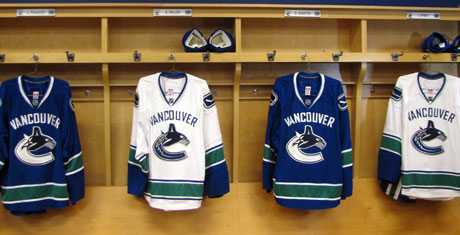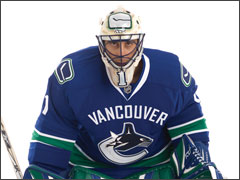Just Cancel All Scheduled NHL Games until the PA Agrees to Outlaw Goalies
"Scoring down again in the NHL this season but what's the answer?"
As I read this headline this week, I was mildly confused, but decided to give the Canadian Press the benefit of the doubt, even if one of their writers did commit three counts of the grammatical crime "could of" in a recent article.
I could only assume that this opening question was meant to be clever or was just poorly expressed, and that the implication of low scoring's problematic nature would be explained as I read further. For the closeness with which I follow the actual game of hockey, I must admit that I don't follow the business side of it with quite as much fervor as others. Perhaps this purported need for more goals has something to do with a U.S. television deal. Maybe the NHL needs to average at least 6 goals per game in order to score the big money deal they've been waiting for, in order to get the game into more American homes. I don't know. The point is that this article didn't tell me anything of the sort, so I had to search elsewhere.
A scouring of various business journals got me nowhere, the NHL's Collective Bargaining Agreement held no revelations on the subject, and the much-respected Commissioner Bettman could not be reached for comment. So I decided to actually watch the game and see whether I had missed something in my thousands of played and watched hockey games. I resolved that, during the next hockey game I watched, I would gauge my reaction to the game on a continuum ranging between wanting to turn the game off at once and heart-pumping, edge-of-my-seat action. This reaction would then be compared to the number of goals scored at the end, and the results stored in a log (in a spreadsheet, of course). If I did this for the remainder of the season, surely I would begin to see some sort of positive correlation.
Actually, I felt pretty stupid. Judging from the headline that I had read, every other hockey fan in the world already knew why a low level of scoring was bad, and I'd probably be the last person to find out. I had always thought myself to be particularly good at recognizing patterns and relationships, but it seemed that I may have missed a big one.
Ah, great! The Canucks play the Oilers tonight. Unfortunately, personal bias might have a strong effect on my level of positive or negative reaction, but the Sedins are always good for a few goals against Edmonton, and these two fast teams with depleted defenses could put quite a few in the nets at both ends. What better game could there be with which to start my experiment?
9:00 arrives. I turn on my computer. My mind is clear. I forget every hockey game I have ever seen. I am ready to receive and to judge objectively. But what do I see? Big hits. Fast skating. Even-strength scoring chances. Chances off the rush. Huge saves. Skilful passing. End-to-end action. This is not what I signed up for. I was promised plenty of whistles and power-plays, multiple 5-on-3 situations, puck-over-glass penalties, phantom hooking infractions, instigator penalties, hits punishable by suspension, at least ten goals, and a totally not silly gimmick to determine who gets a bonus point after all's said and done. But I only got one of those things (the non-gimmick). That game was so lackluster and painful to watch, that I decided I had to write this post immediately, rather than waiting until the end of the season as I had originally planned. The only silver lining is that the entire American audience that were actually able to tune into the NHL Network's broadcast of the game probably fell asleep before they discovered the result of this disaster on ice. I mean 0-0? What a waste of three hours. THIS IS AN OUTRAGE.
Seriously, though, game of the year.
Here's the thing:
Games from higher-scoring eras were more often exciting not because they had more goals. They were, on average, more high-scoring games because the game was played in a more exciting way. They were more exciting because more goals could have happened, not because more goals did happen. Perhaps the executives believe that enlarging the nets will encourage teams to try to score because it will be easier to do so, but I don't think teams are going to change their strategies significantly because of an extra inch on either side of each goaltender. But if they do, and teams still want to play good defense, they are going to. The real problem is that these people don't seem to be looking at the way the game is being played, they are simply looking at the numbers. They truly seem to believe that the ends justify the means in this case—that more goals are better than fewer goals, period. (By the way, enlarging the nets would improve one aspect of the game—to increase the excitement in simple plays such as shots off the wing—but enforcing stricter regulations on goalie equipment would do this job just as well and others better.)
The longer tonight's game stayed tied, the more exciting it was to watch. While tied, the next shot for either team could have been extremely important, especially as the score remained 0-0 into the third period. The perceived chance of a play resulting in a goal is what makes a play exciting, and the perceived chance of that goal being important to the game's outcome makes it even more so. I understand that nobody wants hockey to turn into soccer, but until they extend the ice surface length to a half-mile and we start seeing only three to five legitimate scoring chances per team per game (admittedly, we saw this in the Vancouver/Dallas Western Conference Quarterfinal last year), we don't need to worry about that. There were excellent scoring chances throughout the game tonight, but there were also two goalies playing at the tops of their games. Each potential goal was like two exciting plays in one: the chance and the save. As long as the possibility for a goal is there, why shouldn't this combination be positively thrilling? Maybe I just love the game too much.
Obstruction is down, players are able to use their speed, defense is strong, and now power-plays seem to be down slightly as well. If this trend continues, there's no reason to think that, even without any extra rule changes, a 2-1 game tomorrow won't be more exciting than it was in 1998, 2004, or 2006.
Labels: Hockey




